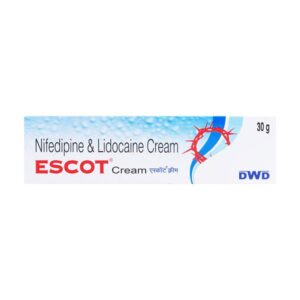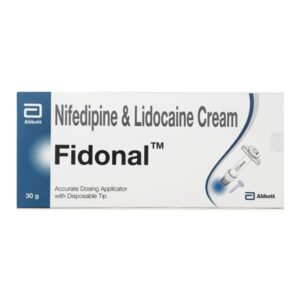NIFEDIPINE + LIDOCAINE (LIGNOCAINE OR XYLOCAINE)
Nifedipine: Nifedipine is a prescription medication used to treat high blood pressure and angina (chest pain). It belongs to a class of drugs called calcium channel blockers.
Its mechanism of action involves blocking the entry of calcium ions into the smooth muscle cells of blood vessels and the heart. By doing so, it relaxes and widens the blood vessels, reducing the workload on the heart and improving blood flow. This leads to a decrease in blood pressure and relief from angina symptoms.
Nifedipine is available in various forms, including immediate-release tablets, extended-release tablets, and capsules. The dose and dosing frequency depend on the formulation and the condition being treated.
For high blood pressure, the usual starting dose is 30 mg to 60 mg once daily for immediate-release tablets, while for extended-release tablets, the starting dose is typically 30 mg once daily. The dose can be increased if necessary, under the guidance of a healthcare professional. For angina, the usual starting dose is 10 mg to 20 mg, three times a day.
Like any medication, nifedipine can cause side effects. Common side effects may include headache, dizziness, flushing, swollen ankles, and constipation. Some people may experience more serious side effects such as low blood pressure, irregular heartbeat, rash, or difficulty breathing. If any of these occur, it is important to seek immediate medical attention.
It’s worth noting that nifedipine may interact with other medications, so it’s essential to inform your healthcare provider about all the medicines you take, including over-the-counter drugs and supplements.
Overall, Nifedipine is a widely used drug that helps manage high blood pressure and angina by relaxing blood vessels and reducing the workload on the heart. It is important to follow the prescribed dose and discuss any concerns or side effects with a healthcare professional.
Lidocaine (lignocaine Or Xylocaine): Lidocaine, also known as lignocaine or Xylocaine, is a medication used to numb or temporarily reduce pain sensation. It belongs to the class of local anesthetics and is commonly used in various medical procedures, such as dental work, minor surgeries, and epidurals during childbirth.
The drug works by blocking the generation and conduction of nerve impulses in the area where it is applied, thereby reducing pain and discomfort. Lidocaine achieves this by inhibiting the voltage-gated sodium channels in the nerve fibers, preventing the transmission of pain signals from reaching the brain.
The dosage of lidocaine varies depending on the route of administration and the specific procedure being performed. It is available in various forms, including creams, gels, sprays, solutions, and injections. The dosage and application instructions should be followed as directed by the healthcare professional.
Lidocaine can cause certain side effects, although they are generally mild and temporary. Common side effects may include skin redness or rash at the application site, itching, swelling, numbness, or a burning sensation. These effects usually resolve on their own without requiring any medical intervention. However, if any severe or persistent side effects occur, it is best to seek immediate medical assistance.
In some cases, lidocaine can rarely lead to more serious side effects, such as an allergic reaction (e.g., hives, difficulty breathing) or systemic toxicity if too much of the drug is absorbed into the bloodstream. Systemic toxicity can lead to symptoms like dizziness, confusion, seizures, irregular heartbeat, or loss of consciousness. Therefore, following the correct dosage and guidelines is crucial to minimize the risk of adverse effects.
It is important to note that lidocaine should only be used under the supervision of a healthcare professional, and the medication should not be self-administered without proper medical guidance.



